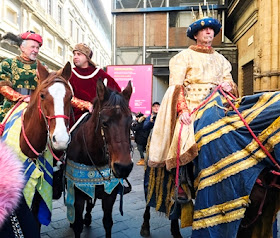 |
| Figure 1: Actors depicting the Three Wise Men in an Italian Epiphany Parade (Source: Ruffner 1) |
According to Christians, Jesus was born on December 25, but the Three Wise Men did not arrive with their gifts to commemorate his birth until 12 days later, on January 6. This day is known as Epiphany, which is celebrated in various ways among some cultural groups. For Italians, it is an important national holiday wherein businesses close and large community wide festivities commence. Italians are entertained by parades full of marching bands, performers, the “Three Wise Men,” and La Befana, popularly referred to as Italy’s Christmas witch (Figures 1 & 2). Yes, a Christmas witch, but unlike what may come to mind La Befana is a benevolent individual who plays an important role in Italian folklore and culture. This blog post will explain more about La Befana.
La Befana reportedly dates to the 8th century, but her name was first recorded in 1549. It is believed that La Befana is a derivative of the Greek word “epiphany”, which coincides with her relationship with this sacred holiday. According to Italian folklore La Befana was an old, impoverished woman who paid a kindness to the Three Wise Men as they journeyed to Bethlehem to receive baby Jesus. There are variations on the legend. One claims she allowed the men stay in her home free of charge for a night, but another says that she merely gave them what little food she had to spare, some water, and directions to their destination. They encouraged her to join them on their journey, but La Befana, the devoted housekeeper, declined, citing the need to keep her house clean. Shortly after the men left, she realized that she made a mistake. She loaded up a collection of fruit to gift baby Jesus and grabbed her broom as she began her trek to catch up with the Three Wise Men. Ultimately, she failed to catch up to them, but she visited various homes along the way, giving the children in the home a gift in case one of them was the newborn babe she was looking for. She continues this trek annually, starting on the night of January 5, in hopes of fulfilling her mission of meeting the men and ultimately Jesus.
 |
| Figure 2: La Befana Figurines (Source: Ruffner 1) |
Scholars believe that the tale of La Befana has deeper roots and a longer history among Italians. It may have been a carry over of an old Pagan tradition wherein an entity associated with Mother Nature was celebrated at the end of December. As Italians converted to Christianity they appropriated this important pagan deity into their new Christian rituals associated with Jesus and Epiphany.
Today, La Befana is considered a cherished cultural symbol and her acts of kindness replicated within Italian homes. She is depicted as an old woman with a crooked nose, rags of a dress, and a long scarf that she wears to cover her grey hair and keep her warm. Throughout the night before Epiphany La Befana flies from house to house, entering the homes through either a keyhole or a chimney. Families are expected to leave a glass of wine (to keep her warm), as well as some sausage and broccoli, reportedly her favorite foods that she eats to sustain her on her journey. The morning of January 6 is welcomed by children who awake to see what La Befana left them. Good children are traditionally gifted dried fruits and candy, whereas naughty children are left coal (a tradition similar to the German St. Nicholas custom).
While La Befana remains an important cultural symbol throughout Italy, demonstrating a mixture of old and new traditions, customs, and values, there continues to be changes in how she is celebrated. There are large scale La Befana festivals throughout the country, with the largest being celebrated in the city of Urbania. Throughout the day of Epiphany (January 6) people celebrate the Three Wise Men and La Befana, the latter of whom is commemorated through the consumption of her favorite foods and drink throughout the day. There has also been an element of commercialization of La Befana that has crept into the holiday. Vendors sell a variety of La Befana figurines and goods, and children no longer receive small gifts of fruit and candy but instead larger gifts, like what you would expect under an American Christmas tree.
Works Cited
Correale, Marta. "La Befana: the story of Italy’s Christmas witch." 1 June 2016. Learning Escapes. Electronic. 24 November 2024.
Giglio, Von Michael. "Taking Flight with Italy's Holiday Witch." Spiegel International 12 December 2008. Electronic.
No Author. "La Befana: The Italian Christmas Witch." n.d. House of Good Fortune. Electronic. 24 November 2024.
Ruffner, Allison. "Italy: La Befana." 2017. University of Delaware Abroad Blog. Electronic. 24 November 2024.
This is a wonderful post I really enjoyed learning about a new and rich tradition of the Italian people. The traditions surround La Befana and her role in the Italian Epiphany celebrations and being known as the Christmas Witch was every entertaining an insightful to a new tradition for me to learn about.
ReplyDeleteI learned that in Italy they celebrate Epiphany with numerous celebrations and having the Three Wise Men and La Befana (Christmas Witch) in parades. La Befana has existed for centuries and, according to Italian folklore, brought kindness to the Three Wise Men as they traveled. There are a variety of possible origins of La Befana and stories of her, but today she serves as a cultural symbol and Italians replicate her acts of kindness throughout their homes. I enjoyed reading this post and learning about Italians Christmas and Epiphany traditions surrounding the Three Wise Men and La Befana.
ReplyDelete-Maryah Hoback-Blair